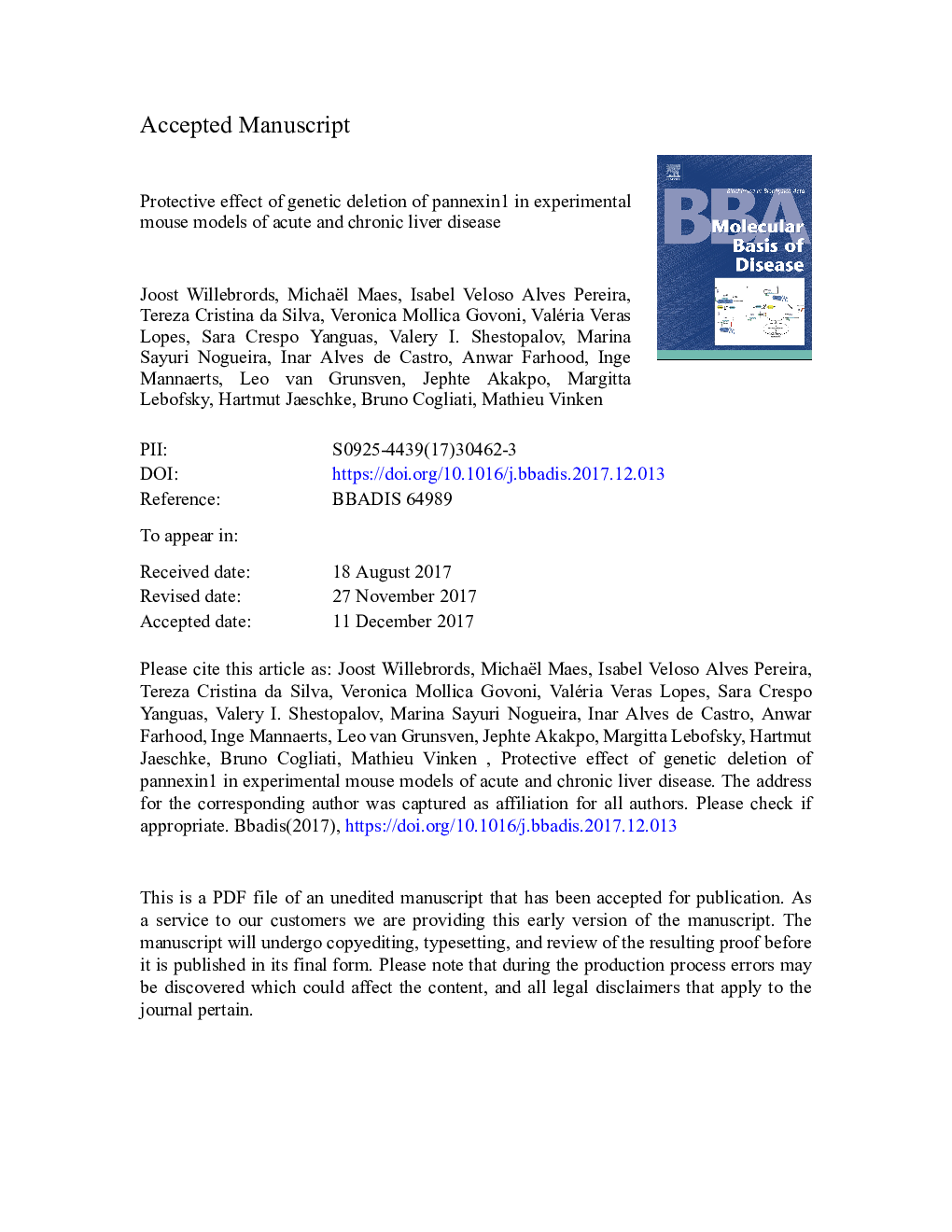| Article ID | Journal | Published Year | Pages | File Type |
|---|---|---|---|---|
| 8258634 | Biochimica et Biophysica Acta (BBA) - Molecular Basis of Disease | 2018 | 47 Pages |
Abstract
Pannexins are transmembrane proteins that form communication channels connecting the cytosol of an individual cell with its extracellular environment. A number of studies have documented the presence of pannexin1 in liver as well as its involvement in inflammatory responses. In this study, it was investigated whether pannexin1 plays a role in acute liver failure and non-alcoholic steatohepatitis, being prototypical acute and chronic liver pathologies, respectively, both featured by liver damage, oxidative stress and inflammation. To this end, wild-type and pannexin1â/â mice were overdosed with acetaminophen for 1, 6, 24 or 48Â h or were fed a choline-deficient high-fat diet for 8Â weeks. Evaluation of the effects of genetic pannexin1 deletion was based on a number of clinically relevant read-outs, including markers of liver damage, histopathological analysis, lipid accumulation, protein adduct formation, oxidative stress and inflammation. In parallel, in order to elucidate molecular pathways affected by pannexin1 deletion as well as to mechanistically anchor the clinical observations, whole transcriptome analysis of liver tissue was performed. The results of this study show that pannexin1â/â diseased mice present less liver damage and oxidative stress, while inflammation was only decreased in pannexin1â/â mice in which non-alcoholic steatohepatitis was induced. A multitude of genes related to inflammation, oxidative stress and xenobiotic metabolism were differentially modulated in both liver disease models in wild-type and in pannexin1â/â mice. Overall, the results of this study suggest that pannexin1 may play a role in the pathogenesis of liver disease.
Keywords
monokine induced by interferon-γNASTECKAPAPBLCGCSFALTGSSGNAFLDNACHT, LRR and PYD domains-containing protein 3SDFI-TACsTNFRGPXGSHTCACD30LHSCsLSECsCYP2E1NALP3MIPMCPMIGAdenosine TriphosphateATPASTAspartate aminotransferaseAlanine aminotransferaseProbabilityNon-alcoholic steatohepatitisAcetaminopheninflammationinterferonIFNinterleukinnon-alcoholic fatty liver diseasestandard error of meannormal dietTIMPSODLiver sinusoidal endothelial cellsHepatic stellate cellsHepatotoxicitySuperoxide dismutasecytochrome P450 2E1Stromal cell-derived factorgranulocyte colony-stimulating factorSEMmetalloproteinase inhibitorAcute liver failureNAFLD activity scoreNash wild-typePanxpannexinmacrophage inflammatory proteinmonocyte chemoattractant proteinthymus-expressed chemokineGlutathioneglutathione disulfideglutathione reductaseglutathione peroxidaseSoluble tumor necrosis factor receptor
Related Topics
Life Sciences
Biochemistry, Genetics and Molecular Biology
Ageing
Authors
Joost Willebrords, Michaël Maes, Isabel Veloso Alves Pereira, Tereza Cristina da Silva, Veronica Mollica Govoni, Valéria Veras Lopes, Sara Crespo Yanguas, Valery I. Shestopalov, Marina Sayuri Nogueira, Inar Alves de Castro, Anwar Farhood,
